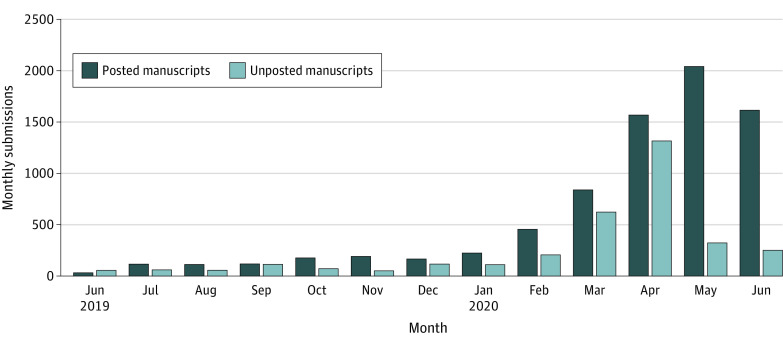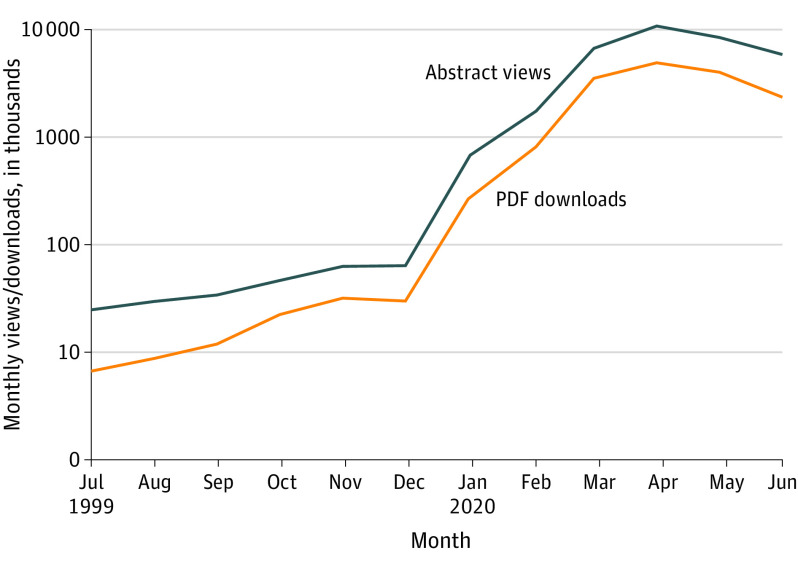Abstract
This study describes submissions, postings, abstract views, downloads, comments, and withdrawals on the medRxiv preprint server from June 2019 to June 2020 and compares submissions and postings before and after COVID-19.
Preprint servers offer a means to disseminate research reports before they undergo peer review and are relatively new to clinical research.1,2,3,4 medRxiv is an independent, not-for-profit preprint server for clinical and health science researchers that was introduced in June 2019.4 A central question was whether there would be adoption of a new approach to dissemination of pre–peer-review science. Now, a year after its establishment, we report medRxiv’s submissions, posts, and downloads.
Methods
We used data from the medRxiv website,5 internal data, and Altmetric.com from launch on June 11, 2019, through June 30, 2020. We assessed submissions, postings, abstract views, downloads, comments, and withdrawals. We also looked at submissions and postings before coronavirus disease 2019 (COVID-19) (July 1 through December 31, 2019) and after COVID-19 (January 1 through June 30, 2020). We calculated the posting rate as the percentage of submissions that were posted after passing screening criteria. These criteria include the requirement that the manuscript is a full scientific research report (not a narrative review, commentary, or case report); the absence of obscenity, plagiarism, or patient identifiers; and confirmation by an affiliate (a member of the scientific community who voluntarily screens submissions) that posting would not pose potential risk to patients or public health.
We also identified medRxiv preprints with the top Altmetric scores. We searched PubMed and CrossRef on June 30, 2020, to determine if any posted preprints had been published.
Results
In its first complete month (July 2019), medRxiv had 176 submissions, of which 116 (66%) passed screening and were posted. During the most recent month (June 2020), there were 1866 submissions and 1615 (87%) were posted. As of June 30, 2020, medRxiv had 11 052 submissions and 7695 (77%) were posted (Figure 1) from 57 096 unique authors in 124 countries. Thus far, 22% of submissions have been revised at least once. In July 2019, there were 6800 article downloads and 25 300 abstract views, whereas there were 2 356 900 and 5 853 600 in June 2020, respectively (Figure 2).
Figure 1. medRxiv Submissions From Launch Through June 30, 2020.
Unposted manuscripts are those that were screened and not posted on the preprint server. Posted plus unposted manuscripts together represent total submissions.
Figure 2. medRxiv Use, as Measured by Abstract Views and Downloads, From Launch Through June 30, 2020.
Source: medRxiv.
In the pre–COVID-19 period, the median number of submissions per day was 6 (interquartile range, 4-8), in contrast to 51 (interquartile range, 23-83) in the post–COVID-19 period. COVID-19 submissions comprised 73% of the total posted in February-June 2020. Overall, 31% of COVID-19 submissions were not posted because they did not meet the screening criteria.
Among preprints posted through June 30, 2020, there were 28 with Altmetric scores of 3000 or greater and 90 with scores of 1000 or greater. The 20 highest Altmetric scores ranged from 3727 to 20 607. In total, 698 preprints have received comments on the medRxiv site (9%). Overall, to date, 14% of the preprints posted through June 30, 2020, have been published in 532 peer-reviewed journals. The median interval between posting and journal publication was 141 days for non–COVID-19 articles and 46 days for COVID-19 articles. A total of 18 (0.002%) preprints were withdrawn after posting on medRxiv, including 13 that were pandemic related.
Discussion
In its first year of operation, medRxiv had 11 052 submissions. While submissions increased steadily from launch to December 2019, COVID-19–related submissions contributed to the rapid growth in 2020. To date, 14% of preprints have been published in scientific journals, but the time frame for completing the peer-reviewed publication cycle was short. Nine percent of preprints received on-site comments, but this represents only a fraction of the interactions, as they are also occurring elsewhere, such as on social media. A small percentage of preprints have been withdrawn (n = 18; 0.002%), including 13 since January 2020 and related to COVID-19 reports. The screening resulted in a 31% denial rate, but data on the reasons for failing screening criteria were not collected. Future studies should evaluate medRxiv after COVID-19, including the extent to which preprints that are published change in response to feedback from the scientific community and peer review, and the potential influence that preprints posted to the server have had on clinical research.
Section Editor: Jody W. Zylke, MD, Deputy Editor.
References
- 1.Krumholz HM, Ross JS, Otto CM. Will research preprints improve healthcare for patients? BMJ. 2018;362:k3628. doi: 10.1136/bmj.k3628 [DOI] [PubMed] [Google Scholar]
- 2.Lauer MS, Krumholz HM, Topol EJ. Time for a prepublication culture in clinical research? Lancet. 2015;386(10012):2447-2449. doi: 10.1016/S0140-6736(15)01177-0 [DOI] [PMC free article] [PubMed] [Google Scholar]
- 3.Maslove DM. Medical preprints: a debate worth having. JAMA. 2018;319(5):443-444. doi: 10.1001/jama.2017.17566 [DOI] [PubMed] [Google Scholar]
- 4.Rawlinson C, Bloom T. New preprint server for medical research. BMJ. 2019;365:l2301. doi: 10.1136/bmj.l2301 [DOI] [PubMed] [Google Scholar]
- 5.medRxiv—the preprint server for health sciences. Accessed July 16, 2020. https://www.medrxiv.org




